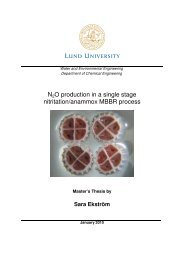Alexander Szabo and Oscar Engle - Svenskt Vatten
Alexander Szabo and Oscar Engle - Svenskt Vatten
Alexander Szabo and Oscar Engle - Svenskt Vatten
You also want an ePaper? Increase the reach of your titles
YUMPU automatically turns print PDFs into web optimized ePapers that Google loves.
Summary<br />
Malaysia is developing fast <strong>and</strong> is striving to become a fully developed country by 2020. After<br />
independence in 1957 from Great Britain, Malaysia has gradually set up goals for its waste water<br />
management, which often goes together with economical development <strong>and</strong> growth. Most of the waste<br />
water treatment facilities built so far have been made simple <strong>and</strong> in form of treatment ponds, septic tanks<br />
<strong>and</strong> low flushing latrines. In this project a treatment pond at UTM in Johor Bahru has been analyzed. At<br />
present, the management of UTM is not satisfied with the treatment efficiency <strong>and</strong> is looking for options<br />
to upgrade the pond or replace it with an activated sludge system. The objective of this study is to propose<br />
an upgraded waste water treatment facility to the current treatment pond.<br />
The treatment pond consists today of two parallel lines, each line with a facultative pond followed by a<br />
maturation pond. After treatment the water is discharged to a stream close to the treatment pond. At two<br />
occasions in November 2009 <strong>and</strong> one occasion in January 2010 sampling <strong>and</strong> flow measurements were<br />
performed at the treatment pond. During each occasion sampling <strong>and</strong> flow measurements were made<br />
every second hour for 24 hours. This was made to get the characteristics <strong>and</strong> behavior of the waste water<br />
quality <strong>and</strong> the waste water flow. The samples were analyzed <strong>and</strong> the amount of Chemical Oxygen<br />
Dem<strong>and</strong> (COD), Biological Oxygen Dem<strong>and</strong> (BOD) <strong>and</strong> Total Suspended Solids (TSS) were measured.<br />
The analysis of the data shows that the concentration of COD, BOD <strong>and</strong> TSS is low. It seems there is a<br />
significant infiltration into the sewer network at UTM. This was confirmed by the flow measurements<br />
done at the inlet into the treatment pond. During rain events the influent flow is more than doubled <strong>and</strong><br />
this is something that must be considered when dimensioning a new treatment facility. It seems there is a<br />
possible misconnection between the stormwater network <strong>and</strong> the sewer network at UTM. During these<br />
peaks, the concentration of COD is more than doubled compare to the average COD entering the<br />
treatment pond. The high COD-values are confirmed by higher TSS values during these rain events. The<br />
exact reason for this is unknown but one possible explanation could be that the increased flow in the<br />
waste water pipes will catch <strong>and</strong> carry with it deposits from the sewage pipe. Another explanation could<br />
be that somewhere a stormwater channel is connected to the sewer pipes <strong>and</strong> the stormwater is carrying<br />
organic material from the ground into the pipes which ends up in the treatment pond.<br />
At late night the COD value is low but there is still a significant influent flow. This leads to the<br />
conclusion that the pipe is also taking in groundwater. Together with the increased influent flow during<br />
rain events <strong>and</strong> the high flow at night, the total infiltration is estimated to 60-90% of the total influent<br />
flow.<br />
From the data collected <strong>and</strong> analyzed three different solutions for better treatment efficiency have been<br />
proposed. One solution is an activated sludge system; another is upgrading the current pond by<br />
rearranging the water flow so that it flows in a series through all four treatment ponds. The third<br />
alternative is to add aeration to the upgraded treatment pond as calculations shows that the area is not<br />
sufficient <strong>and</strong> therefore it is overloaded. A review of the sewer <strong>and</strong> stormwater network should also be<br />
considered in order to find the possible misconnection between the stormwater <strong>and</strong> the sewer water.<br />
iii <br />















